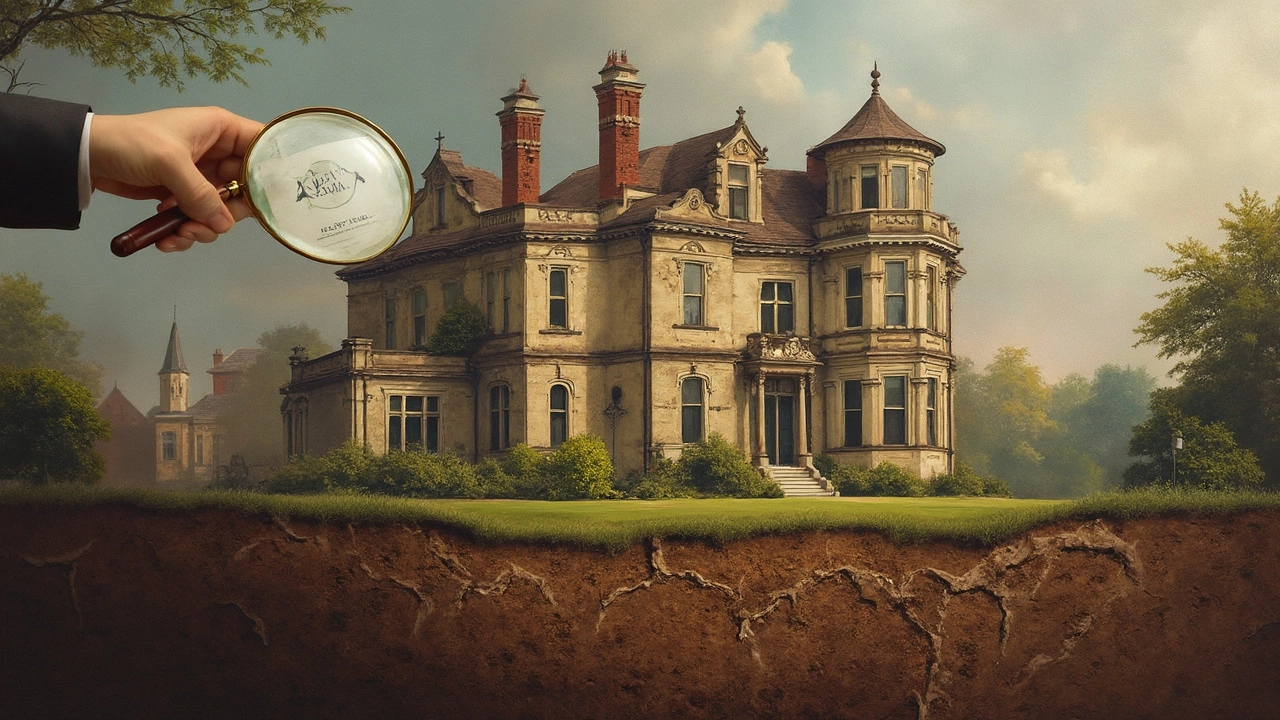Does House Insurance Cover Foundation Issues?
 Feb, 20 2025
Feb, 20 2025
Dealing with foundation issues can be a real stressor. You might be wondering, does house insurance have my back in such scenarios? The short answer is: it depends. Insurance policies have their nuances, and it's not always clear-cut.
First off, most standard home insurance policies do cover sudden and accidental damage. But foundation problems often stem from issues like poor drainage, soil movement, or long-term neglect, which might not be considered 'sudden.' So if you've got a problem brewing over the years, expecting insurance to step in might not pan out the way you hope.
It's crucial to go through your insurance policy with a fine-tooth comb. Some policies have riders or additional coverages that might include specific foundation issues, so it's worth checking out.
- Understanding Foundation Issues
- Typical Insurance Coverage
- Exclusions You Should Know
- Importance of Regular Maintenance
- Factors Influencing Premiums
- Tips for Preventing Foundation Problems
Understanding Foundation Issues
Foundation problems are the stuff of nightmares for homeowners. They can sneak up on you when you least expect it, leaving you with a hefty repair bill and a mess to sort out.
So, what exactly causes these issues? Well, often it comes down to things like the type of soil your house is built on. Some soils expand and contract with moisture, which can crack your foundation. Poor drainage is another common culprit; if water isn't directed away from your home, it can erode the foundation over time.
Common Signs of Foundation Issues
- Cracks in the walls or floors: These can appear as small hairline fractures or larger breaks. Either way, they shouldn’t be ignored.
- Doors and windows that stick: If they suddenly won't close properly, foundation shifting might be the issue.
- Uneven floors: Notice if things seem to roll on their own or if tiles are lifting.
While these signs are common foundation issues, they don't always point to a severe problem. It's tricky business determining whether it's a minor hiccup or a full-blown catastrophe.
Regular maintenance is key to catching these issues early and saving a ton of cash in the long run. Fixing small problems quickly can prevent them from spiraling into disasters.
Foundation Materials Matter
Not all foundations are created equal. The materials used when your home was built greatly impact its foundation. Concrete slabs, for instance, are common and durable but not immune to shifting soil. Pier-and-beam systems, on the other hand, are more adaptable to movement but may have other vulnerabilities like water seepage damages.
Understanding your foundation's construction helps you make smarter decisions about repairs and insurance claims. Make it a habit to check for signs of trouble, especially after heavy rains or during extreme droughts, when the ground is more likely to shift.
| Foundation Type | Pros | Cons |
|---|---|---|
| Concrete Slab | Durable, low cost | Hard to repair, susceptible to soil movement |
| Pier-and-Beam | Easy to access for repairs | Prone to water damage |
In the end, house insurance may or may not cover foundation issues, but understanding the root cause of these problems can help you prevent them from worsening. Stay alert, keep up with maintenance, and you might just stay ahead of any potential disasters.
Typical Insurance Coverage
So, you're trying to figure out if your house insurance covers foundation issues. Here's the scoop: most insurance policies are designed around unexpected events like fires, burst pipes, or wind damage. The tricky thing about foundations is that the issues creep up over time, so insurers may not consider them 'unexpected'.
Here's what you might find in a typical policy:
- Accidental Damage: If a burst pipe causes sudden water damage to your foundation, there’s a good chance that’s covered because it was unexpected.
- Earthquakes and Floods: Some policies exclude these, but if your area is prone, look into getting additional coverage. Foundation damage from natural disasters usually needs a specific policy or rider.
- Subsidence: This is a big one. Many standard policies don’t cover it unless it's specifically included. Some companies might offer additional coverage for subsidence issues, so it's worth inquiring.
If you’re staring down some potential foundation repairs, take a moment to dive deep into your policy's wording. Insurers often have a way of phrasing things that might exclude coverage. It might sound dull, but truly understanding what you've signed up for can save you from any nasty surprises down the line.
And remember, even if your policy doesn’t seem to cover foundation repair, some companies offer an endorsement or rider for an extra cost. It could be worth it if you’re in a high-risk area or an older home. Keep your options open and consider what's financially smartest for you.
Exclusions You Should Know
When it comes to house insurance, not everything is sunshine and rainbows, especially with foundation issues. While certain damages might be covered, a lot is usually not. Understanding what falls in the exclusion zone can help manage expectations and avoid surprises.
Common Exclusions
Many house insurance policies tend to exclude damages caused by natural wear and tear over time. If your foundation troubles stem from poor initial construction or gradual settlement, you're likely out of luck with your claim.
Another biggie? Water damage. Plenty of policies draw the line at water-related woes. Whether it’s due to faulty plumbing, plumbing leaks, or flooding, these are typical exclusions unless you have an additional endorsement.
Earth Movement
Any movement of the earth won't typically be covered either. Whether it's an earthquake or a harmless shift in the soil, such events are often outside the policy scope unless an earthquake rider is in place. Hence, focusing on prevention here is key.
Avoiding Missteps
Policies tend to exclude negligence-related issues. If it's clear you've been skipping basic upkeep tasks, your chances of a successful claim could dwindle. Knowing your policy's fine print can prevent missteps in handling foundation problems.
Additionally, regions experiencing frequent climate changes or with heavy clay soil are more prone to foundation issues. While insurance doesn't typically account for these factors with standard coverage, understanding your geographical risks can be crucial.

Importance of Regular Maintenance
Keeping up with regular maintenance can save you from a heap of trouble later. When it comes to your home's foundation, some preventative steps can make a world of difference.
One of the most effective ways to prevent foundation issues is by managing water around your house. Poor drainage is a major culprit behind foundation damage. Ensure your gutters and downspouts are functioning properly, directing water away from your home. You don't want water pooling at the base of your house, trust me.
Monitor For Changes
Pay attention to your home. If doors start sticking or cracks appear in walls or floors, it might be more than just settling. Catching these signs early makes addressing any underlying problems easier and often cheaper. Don't ignore them; small issues can snowball into something bigger.
"Neglecting regular upkeep is a major risk factor for needing costly repairs," says John Giles, a structural engineer with over 20 years of experience in home inspections.
Maintain The Landscape
Your yard plays a role too. Plants and trees close to your house might look nice, but their roots can mess with your foundation. Keep them in check and consider consulting a professional about safe distances.
Seasonal Checks
Every season presents new challenges. In winter, watch out for water freezing and expanding in tiny foundation cracks. In summer, extreme heat and drought can dry out soil, leading to foundation issues.
By setting up a simple, regular maintenance routine, you can often catch potential problems before they become major headaches. Spending a bit of time now can mean less stress and fewer expenses down the road.
Factors Influencing Premiums
Ever wondered why your house insurance premium is what it is? A few key factors play a big role in shaping those numbers. Understanding these can help you avoid surprises and make informed decisions.
Foundation issues might be one of them, affecting the risk level insurers assign to your property. If your home is in a region with a history of soil movement or earthquakes, expect higher premiums. Insurers aren't keen on taking on what's likely to cost them, so they adjust accordingly.
Location, Location, Location
Location-specific risks significantly sway your premiums. Homes in areas prone to natural calamities, like floods or earthquakes, often attract higher insurance costs. Why? Insurers assess risk profiles based on historical data, and high-risk areas naturally incur more expenses.
Condition and Age of the Home
If your house is older and hasn't been maintained well, your insurance could be pricier. Older homes might have wear and tear issues that increase the likelihood of claims.
Preventive Measures
Here's a tip: investing in prevention could save you a pretty penny. Installing sump pumps, sealing foundation cracks, and ensuring proper drainage systems can make your home safer. Some insurers might even give you a break on your premium for being proactive.
Claim History
Been filing claims often? That's another factor. A history of frequent claims could signal a risk to insurers, pushing up your payments. Keeping claims to a minimum by addressing small issues before they spiral can be beneficial.
Understanding how these factors weave together can help you make better choices when it comes to protecting your home and managing those premium costs.
Tips for Preventing Foundation Problems
A healthy foundation is the backbone of your home, literally! Here are some practical steps you can take to prevent those pesky foundation issues from cropping up.
Maintain Proper Drainage
Water is your foundation's worst enemy. Make sure your gutters and downspouts are doing their job well by directing water away from your house. You don't want water pooling around the base, which can lead to soil erosion.
- Check your gutters regularly for blockages and clean them out as needed.
- Ensure downspouts extend at least five feet from the foundation.
Control Moisture Levels
Keeping consistent moisture levels around your house foundation is crucial. Fluctuating moisture can cause the soil to expand and contract, putting stress on your home's base.
- Use a soaker hose during dry spells to maintain even moisture around the perimeter.
- Consider installing a lawn irrigation system to keep things balanced.
Landscaping Counts
Be smart with your landscaping choices. Trees and shrubs should be planted at a distance, so roots don't interfere with the foundation.
- Place large trees no closer than 20 feet from the house.
- Opt for smaller plants near the foundation to minimize root impact.
Regular Inspections
A little vigilance goes a long way in spotting potential red flags before they turn into expensive repairs.
- Walk around your home regularly to check for cracks in the foundation or walls.
- Look for signs of uneven floors or doors that won't shut properly.
Stats on Foundation Issues
Take a peek at these numbers for a better understanding:
| Problem Type | Percentage of Cases |
|---|---|
| Poor Drainage | 44% |
| Soil Movement | 37% |
| Tree Roots | 19% |
Implementing these easy tips can save you a ton of hassle and help keep your house insurance premiums from jumping. Remember, a little prevention goes a long way in maintaining a solid, trouble-free foundation.
